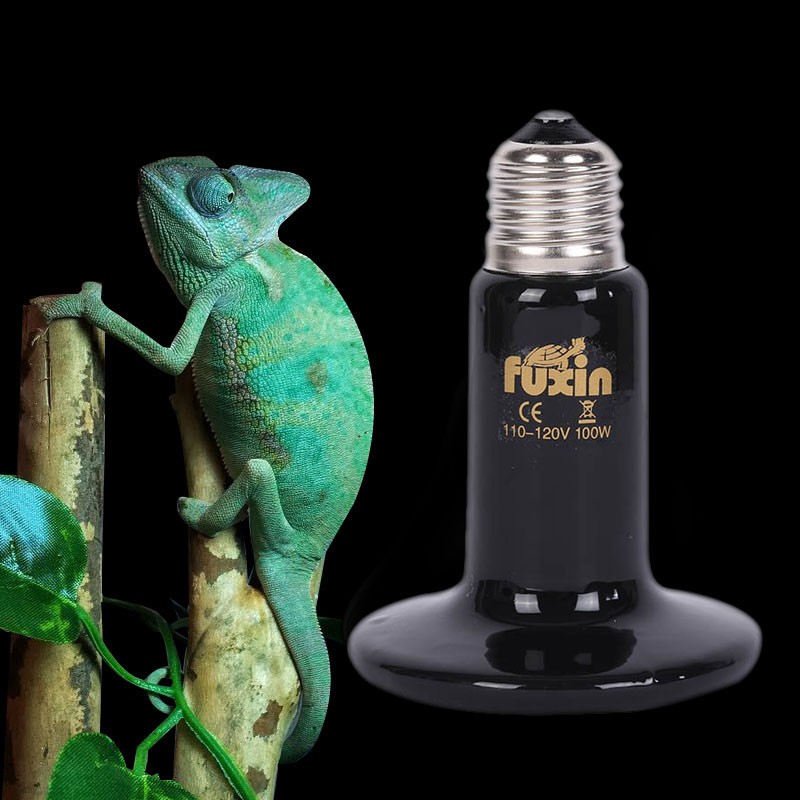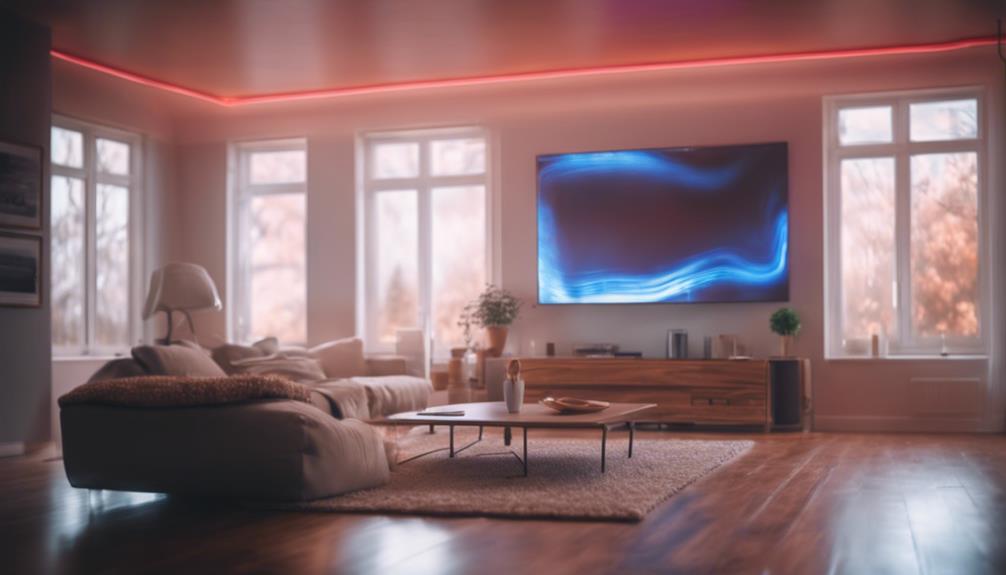
Maximize your home heating efficiency by harnessing the power of infrared technology. Emitting electromagnetic radiation, infrared heating targets objects for direct heat transfer, ensuring even warmth distribution without energy loss through ducts or pipes. When selecting the right infrared heater, consider factors like area size and wattage output – approximately 10 watts per square foot. Mount the heater at recommended heights for best performance, ensuring unobstructed placement. To enhance heat distribution, focus on proper insulation and heater positioning. Follow energy-saving tips and maintenance guidelines to keep your system running efficiently. Master the art of infrared heating for ultimate comfort and savings.
Understanding Infrared Heating Basics

Infrared heating operates by emitting electromagnetic radiation that directly heats objects and surfaces in a space, rather than heating the air. This principle of infrared heating guarantees that heat is distributed evenly throughout the room, as objects and surfaces retain heat and re-radiate it back into the environment.
The benefits of infrared heating include energy efficiency, as it eliminates heat loss through ducts or pipes, and quick heat transfer, providing immediate warmth upon activation. Additionally, infrared heating is known for its targeted heating capabilities, allowing specific areas to be heated without the need to warm the entire room.
Infrared heating principles are based on the transmission of heat through electromagnetic waves, particularly in the infrared spectrum. These waves have the ability to penetrate the air and heat objects directly, creating a comfortable and consistent temperature in the space.
Selecting the Right Infrared Heater
When choosing the right infrared heater for your space, consider factors such as the size of the area you need to heat, the heater's wattage output, and any additional features that align with your heating requirements.
Infrared heaters come in various types, including ceramic, quartz, and panel heaters. Ceramic heaters are suitable for spot heating, while quartz heaters provide instant warmth and are ideal for heating smaller areas. Panel heaters are great for continuous heating and can be mounted on walls or ceilings to save space.
Selecting the appropriate heater size is essential for efficient heating. Calculate the square footage of the area you want to heat to determine the required wattage. As a general guide, you'll need around 10 watts per square foot for standard ceiling heights. However, for rooms with poor insulation or higher ceilings, you may require more wattage.
Consider adjustable thermostats, timer functions, and safety features like tip-over protection when choosing an infrared heater to enhance convenience and safety in your heating system.
Installing Your Infrared Heating System
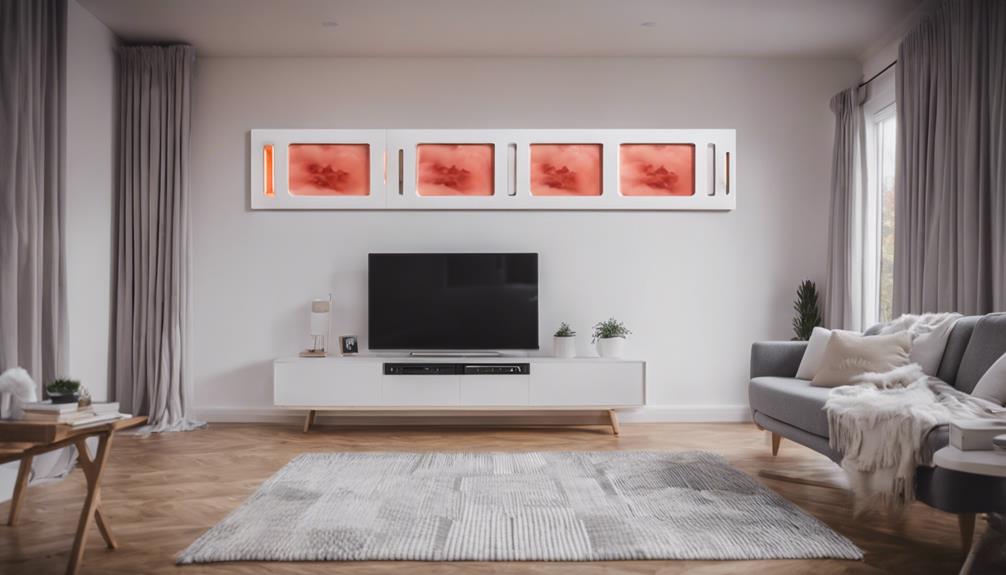
Consider the layout of your space and the ideal positioning of your infrared heating system to guarantee efficient and effective installation. When beginning the installation process, confirm that the chosen location allows for proper heater placement.
Ideally, the infrared heater should be mounted on a wall or ceiling, positioned at a height that allows for best heat distribution. Start by selecting a location that's free from obstructions and at a safe distance from any combustible materials.
Use the manufacturer's guidelines to determine the appropriate mounting height and angle for your specific infrared heater model. Securely mount the heater using the provided brackets and hardware, confirming it's level and stable.
Additionally, verify that the heater is connected to a power source that meets the manufacturer's specifications. It's essential to follow all safety instructions and guidelines outlined in the user manual during the installation process.
Optimizing Heat Distribution With Infrared
To optimize heat distribution with an infrared heating system, verify that the placement and mounting of the heater align with the manufacturer's guidelines for efficient performance. Proper positioning is vital for guaranteeing even heat distribution throughout the room.
Consider the room layout when deciding where to place the heaters. For example, mounting the heater on a wall that faces the center of the room can help radiate heat more effectively. Additionally, make sure that the heater isn't obstructed by furniture or curtains that could block the infrared waves.
Heat retention is key to maximizing the effectiveness of your infrared heating system. To enhance heat retention, consider factors such as insulation, windows, and doors that may affect how well the room holds heat. Proper insulation can prevent heat loss and improve overall energy efficiency.
Energy-Saving Tips for Infrared Heating
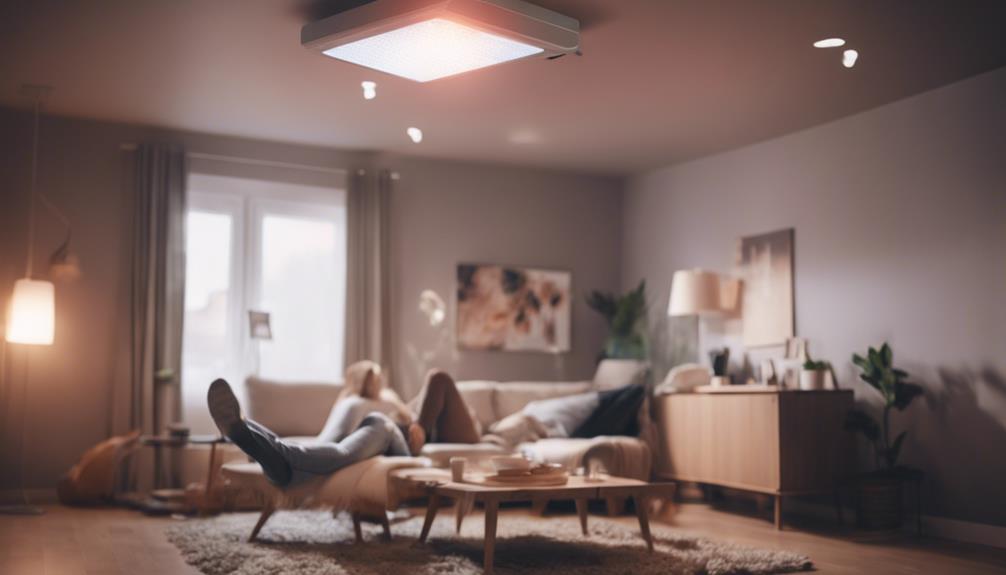
Maximizing energy efficiency with infrared heating involves strategic placement and proactive maintenance measures. To achieve ideal cost savings and energy efficiency, start by ensuring that your infrared heaters are placed in areas where they can directly heat the objects and people in the room. This allows for more focused heating compared to traditional methods, reducing energy waste.
Additionally, consider installing programmable thermostats to regulate the temperature efficiently. By setting lower temperatures when the space isn't in use or during sleeping hours, you can further save on energy costs without sacrificing comfort.
Regularly cleaning the infrared heaters' reflectors and ensuring that they're free from obstructions will also help maintain their efficiency.
Lastly, proper insulation in your home can complement the energy-saving benefits of infrared heating by preventing heat loss. By combining these tips with the unique advantages of infrared technology, you can create a comfortable and cost-effective heating solution for your home.
Maintenance Guide for Infrared Heaters
Guarantee peak performance and longevity of your infrared heaters by following this thorough maintenance guide.
To maximize your infrared heater's lifespan and efficiency, regular cleaning is essential. Begin by unplugging the heater and allowing it to cool completely. Use a soft, dry cloth to gently wipe down the exterior to remove dust and debris. For more thorough cleaning, carefully vacuum the grill and vents to prevent blockages that can hinder heat distribution.
Inspect the infrared heater's cord for any signs of wear or damage, ensuring it isn't frayed or exposed. Check the heating elements for any discoloration or damage, as this can affect the unit's efficiency. Additionally, verify that the heater's thermostat is functioning correctly to maintain ideal temperature control.
Troubleshooting Common Infrared Heater Issues
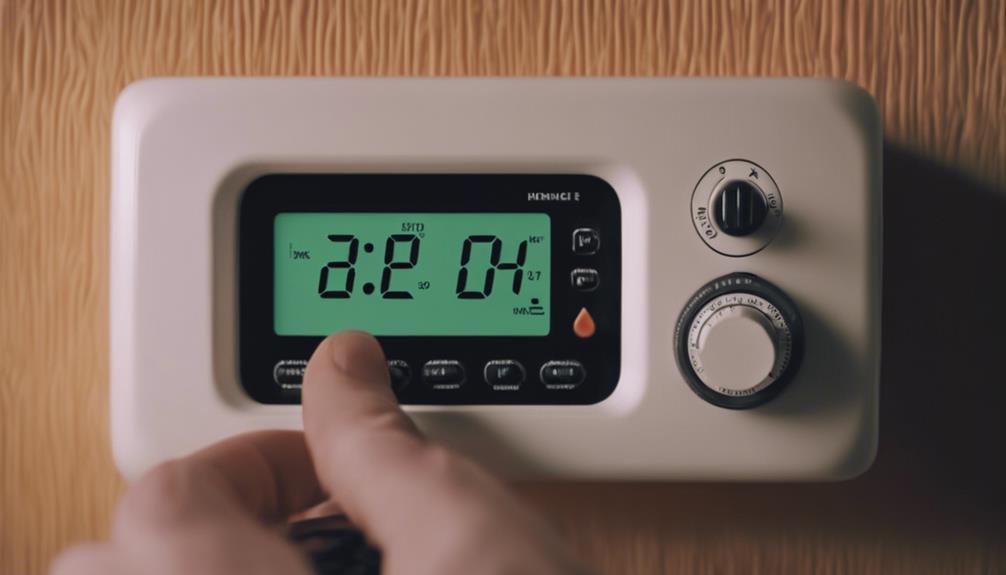
Regularly inspecting and addressing common issues with your infrared heater is essential for guaranteeing ideal performance and longevity.
When troubleshooting infrared heater malfunctions, start by checking the power source to verify it's properly connected. If the heater fails to turn on, inspect the power cord and outlet for any damages.
Infrared heaters may also experience temperature sensor issues, leading to inaccurate readings or irregular heating patterns. To address this problem, carefully clean the sensor with a soft cloth to remove any dirt or debris that may be affecting its functionality.
Additionally, check for any blockages in the heater's air vents that could be obstructing proper airflow.
If the issue persists, consult the manufacturer's manual for specific troubleshooting steps or contact a professional technician for further assistance.
Conclusion
To summarize, by understanding the basics of infrared heating technology, you can make informed decisions about your home heating needs.
Selecting the right heater for your home is crucial for maximizing efficiency and comfort.
Proper installation and optimization of heat distribution will enhance the performance of your infrared heating system.
Following energy-saving tips can further improve efficiency and reduce costs during the colder months.
Regular maintenance is essential to keep your system running smoothly and effectively.
With the ability to troubleshoot common issues that may arise, you can ensure your infrared heating system continues to provide warmth and comfort for years to come.
